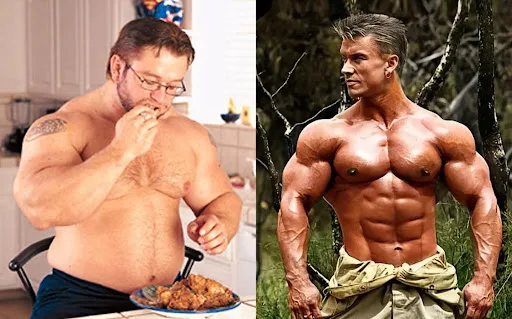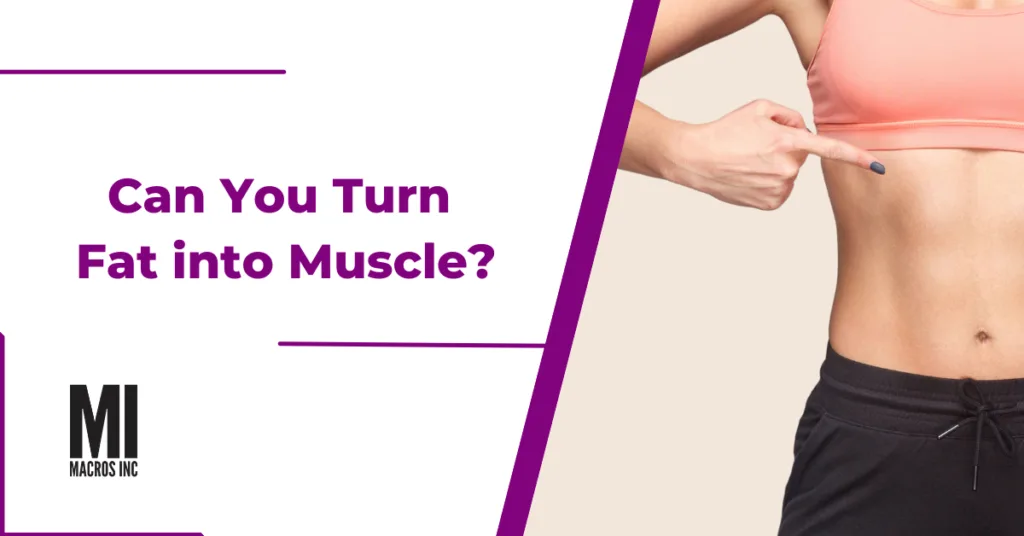When I ask a new client what their goals are, one of the most common responses is “to turn my fat into muscle.” That’s a simple enough request, and I’d wager the majority of us are looking to do something along those lines. However, simple things on paper are not always simple in practice, and there’s more than meets the eye here. As such, I’ll cover how fat loss and muscle gain work, what is and isn’t feasible, and strategies for achieving that goal.
Jump to a Topic
Can You Turn Fat Into Muscle?
Mechanisms
The first thing to understand here is that both muscle gain and fat loss involve exchanges of energy. Everything in your body is made of molecular bonds. These bonds require energy to make, and release energy when they are broken. The primary source of that energy is through the food we eat. Food is also made of molecular bonds, and breaking them down releases energy our bodies can use.
This explanation is a simplification, as there is much more to the details. For our intents and purposes, though, this model addresses things sufficiently. You can think of it like the “calories in = calories out (CICO)” model, as the two are related, and operate on similar principles.
Fat Loss
Fat loss occurs when your body has an energy requirement that exceeds the calories you take in, i.e. a calorie deficit. To make up the difference, your body pulls from the main source of stored energy it has – your bodyfat. When bodyfat is broken back down, it releases energy to be used in your body’s activities and processes. Because energy is being released, and tissues are being broken down, this is considered a catabolic reaction.
Muscle Gain
Muscle gain requires energy in order to synthesize the new tissue. Your body is most efficient at this when you’re in a calorie surplus, as some of the excess energy can be put toward muscle growth. Here, you have an exchange where energy is being used up, and tissues are growing. Therefore, this is known as an anabolic reaction.
The important takeaway here is that in terms of energy, catabolic and anabolic reactions are two opposing processes. This also means fat loss and muscle gain are opposites. This fact is a key point in considering the ability to gain muscle and lose fat simultaneously.
Is It Possible?
Your body goes through countless anabolic and catabolic reactions over the span of a single day. When we talk about things such as fat loss or muscle growth, though, we’re talking about a net change, i.e. the increase or decrease of muscle and fat over an extended period of time. In order to maximize muscle growth, you want to be in a calorie surplus. If you want to see fat loss, this generally requires a calorie deficit.
So while it’s technically possible to do both at once, it tends to be very inefficient outside of a couple specific scenarios (more on these later). But what about converting one to the other, i.e. muscle to fat and vice versa? It’s quite common to hear these concepts passed around in the fitness world, so let’s tackle each separately.
Muscle to Fat
This is a scenario often touted when someone who is fit starts to gain bodyfat, or look less muscular. The myth is that the person’s muscle is being converted to fat. So what’s really happening?
separate processes running simultaneously, with two separate factors driving the change. The muscle loss is generally tied to a reduction in activity levels. Muscles adapt to the stimulus they’re presented with. This is why lifting heavier over time produces muscle growth. Here, the opposite is happening – the lack of stimulus means the tissues are no longer as needed, and will shrink accordingly.
As for the fat gain, this is usually tied to both changes in diet as well as the lack of activity. Here, the increased caloric intake and reduced calorie expenditure create a calorie surplus. Since there is little stimulus for muscle to grow, the majority of the incoming energy is allocated to fat storage.
So no, your muscles won’t turn into fat per se. But, it is possible to lose muscle and gain fat simultaneously.
Fat to Muscle
This scenario is usually brought up when a lifter loses weight, and starts seeing their muscles develop and pop out. As stated above, it’s pretty difficult to lose fat and gain muscle simultaneously due to the differing calorie goals. What’s the deal?
First, it is difficult to lose bodyfat and gain lean body mass simultaneously, as the two goals again require different caloric needs. There are some exceptions to this rule, but I’ll put a bookmark in that for now, as it’ll be discussed more below.
That aside, what is likely happening here is a bit of a visual trick. The leaner you get, the easier it is to see things like muscle definition and separation. While a person may be physically bigger at a higher bodyfat, the muscle definition and prominence when lean give an illusion of extra muscle size. In reality, though, they aren’t gaining a ton of muscle – they’re instead revealing what they already have.
This is easily illustrated with contest bodybuilders. In their off season, they usually walk around at average to higher bodyfat levels as they bulk up or maintain their weight. When they start dieting, though, their muscles are much easier to see, and they achieve the “ripped” look (Figure 1).

Figure 1: A side by side comparison of professional bodybuilder Lee Priest in the offseason vs. contest shape. His off season weight was around 270-285 pounds (122.7-129.5 kg), while his contest weight was about 200-225 pounds (90.9-102.3 kg). His height is 5’4” (162.5 cm).
Strategies for Fat Loss and Muscle Gain
Now that we’ve covered the different scenarios regarding fat loss and muscle gain, let’s discuss strategies for achieving those goals effectively. The two main approaches consist of body recomposition, and bulking and cutting.
Body Recomposition (Recomp)
Body recomposition, AKA “recomp,” is the act of trying to gain muscle and lose fat simultaneously while eating around maintenance calories. This is a particularly useful approach for two specific scenarios, and even more so when the two are combined together.
First, people with large amounts of fat to lose can add substantial lean body mass while at maintenance or even dieting down. As long as they are lifting progressively heavier as they lean out, there will be some increases in muscle to go with the fat loss.
The other situation involves weight training experience. Novices new to resistance training can make appreciable strength and muscle gains around maintenance calories, at least initially. Again, this requires them to challenge their muscles progressively heavier as they go.
The ideal candidate for a recomp would be an overweight individual new to weight training. This type of trainee can expect to make good progress with both fat loss and muscle gain, as long as they’re eating at maintenance calories or lower, and lifting progressively heavier on a balanced program.
However, the effectiveness of a recomp approach is on a sliding scale. The leaner someone gets, and the more advanced they get at weight training, the harder it becomes to achieve both goals simultaneously. For the sake of time efficiency, it becomes more productive to pursue each goal independently. This is where bulking and cutting come in.
Bulking and Cutting
A bulk and cut approach consists of alternating between two different phases, each with a specific physiological goal.
The bulking phase involves eating at a calorie surplus while lifting progressively heavier weights. This maximizes the potential for muscle growth. The only trouble, though, is your body doesn’t partition all of your incoming calories to muscle – it also saves some as fat. The ratio of muscle:fat gain is referred to as the p-ratio. You can minimize and control the amount of incoming fat gain, but you can’t avoid it entirely.
The cutting phase is essentially identical to what most dieters are trying to achieve. It is focused on two things: losing bodyfat, and retaining the muscle that you have. The fat loss requires a calorie deficit, and the muscle retention needs both adequate protein intake and lifting heavy.
These phases alternate with each other, with the long term goal of adding muscle to one’s frame while maintaining or lowering their bodyfat levels. As such, it has the same long term goal as a recomp, just via a different approach.
Bulking and cutting is occasionally mistaken for yo-yo dieting, where someone loses and gains the same amount of bodyfat repeatedly. The two primary factors that set bulking and cutting apart from a yo-yo diet are as follows:
- Bulking and cutting is done in a controlled, sustainable manner. Yo-yo dieting is often associated with crash diets or other unsustainable practices.
- Bulking and cutting’s net goal is to add muscle mass over time – the fluctuations in bodyfat are simply a byproduct of the approach. In a yo-yo diet, there is no goal other than to lose weight.
There are other considerations that go into the bulk and cut approach, but for most lifters, it is a safe and effective way to add muscle while leaning out.
Wrap Up
The concepts of muscle gain and fat loss can be a bit overwhelming at times. However, the most important takeaway here is to stay consistent, and begin weight training if you haven’t already. Dietary approaches refine over time, so it’s okay not to get things perfect from the get go. You can also always consult an expert for advice. As long as you stick to a plan, though, the results will come.
Try our nutrition coaching, for free!
Be the next success story. Over 30,000 have trusted Macros Inc to transform their health.
Simply fill out the form below to start your 14-day risk-free journey. Let's achieve your goals together!

